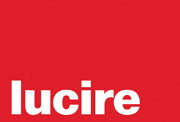|
While most local tour guides will lead visitors around their city
with a great deal of affection and good humor, Haifa guide David
Brown and the management of the historic Colony Hotel in the old
Templar-established German Colony are downright proud of their hometown, and
for good reason. Though Haifa is a port city and a popular weekend
getaway destination for people living in Tel Aviv, it is equal parts
a city of the future as it is of history.
The Colony Hotel, delightfully balancing
old and new, is a perfect starting-point and base either for a Haifa
city break or an extended stay in Israel’s north (which may cover
the Golan Heights and Galilee). Though the building is 103 years
old and has the look and feel of an upper-class private home, it
features modern amenities, elegant-but-comfy rooms and a prolific
breakfast spread with foodstuffs sourced from the local markets.
The Colony Hotel’s manager and staff also treat you like a returning
friend, and will candidly steer you to their personal favourite places
to eat, drink and shop. This decided home-away-from-home is at the
centre of the German Colony, which itself benefited from a gentrification
renaissance in the ’80s and ’90s and is now peppered with colourful
bars, cafés and a mall featuring outlet stores with discounts on
several popular Israeli clothing brands, as well as shops selling
travel essentials such as SIM card for your cellphone.
continued below
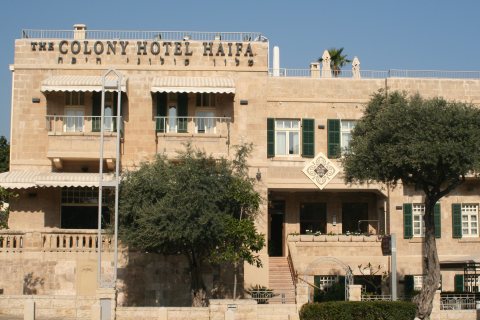
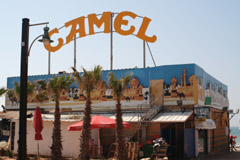 

On my first night in town, Brown arrives a good 30 minutes before
our appointed time so he can show me why Carmel Centre is a must-do
hub of entertainment for somebody new to the city. Granted, the
neighbourhood was more alive than usual given that it happened to
be Purim (best explained to non-Jews as a festive answer to Hallowe’en),
but Brown still emphasized that the neighbourhood was bustling almost
as much on any weekend or holiday night. In addition to diners and
revellers, there was also a small but wonderful local craft fair,
interesting boutique storefronts and an impressive array of street
food.
Though my guide coyly tries engage me in a quick sandwich food
purchase with some of the vendors and with popular carry-out sandwich
place Zesty (which has a particularly enormous line of people),
he ultimately has something better in mind, knowing I am a foodie.
He takes me past Zesty into a courtyard that gives way to a festive,
aromatic restaurant simply named Meat. He reveals that
Zesty is the fast food extension of that dining establishment.
Despite its straightforward name, Meat is a hidden gem—sophisticated
and savvy, even though it doesn’t quite fit the fine dining, bistro
or casual dining categories. All the steak dishes, big enough to
share, arrive artfully arranged on sizzling plates. A filet mignon
flanked bacon, cheese and green beans is smoked for five hours in
a special smoke chamber and then oven-roasted for twelve, giving it a
decadent butter texture.
The predominantly Israeli wine selection is also impressive, and
the owners (Ron Galanti and Tzahi Yarhi) are also intent on helping
you choose the perfect match for the specific steak or fish dish
you order. You don’t just order a cabernet. Ron insists upon something
sublime like Odem Mountain’s Cabernet 2009 Reserve, aged for 24
months and a 2012 winner of the Terra Vino world wine competition.
The salads and sides, meanwhile, reflect that the owners not only
have a good handle on the global “farm-to-table” restaurant
trend, but also a very unusual spin on it.
The next morning, Brown starts off the day with a quick tour around
the German Colony quarter, telling fascinating stories behind various
landmark buildings as well as eccentric historic figures such as
19th century author, mystic and diplomat Lawrence Oliphant, who
hired Naftali Herz Imber (best known as the author of the ‘Hatikvah’
lyrics) as his secretary. There is also a stop at the the Haifa
City Museum, built in a former Templar school, which was hosting
an Indian and Arab Cinema film festival, as well as Just Meat,
another high-concept un-steakhouse staged in the space of a former
French restaurant inside a building dating to 1872.
A vibrant 300 m stretch leads to the foot of the hill where
UNESCO heritage site-certified Baha’i Gardens stands as a living
testament to the success of multiculturalism and tolerance here.
Brown smiles broadly when he talks about how everyday life in Haifa
defies any preconceptions people may have about Israel in general,
and in the most cheerful, life-affirming ways. While there are three
distinct quarters for Jews, Christians and Muslims, the borders
blur and people mix freely at area markets. The presence of Haifa
University and a business quarter housing outposts of some of the
world’s largest high-tech companies make it as much of a
world future city as it does a world heritage spot.
Once I had my historical bearings, we drive to the pinnacle of
the hill that is home to the Baha’i Temple to wander its gardens
and the interiors open to the public. Even with the awe-inspiring
spread and panoramic views, Brown insists you cannot really grasp
Haifa’s whole-hearted embrace of coexistence unless you see the
rest of the city in its proper context.
The next stops are to Dado
Beach and Meridian Beach to view rare plant life specimens and engage
in prime people-watching, and a pass by Haifa University and Technion—Israel Institute of Technology.
After more scenic strolls through some of Haifa’s more affluent
hillside neighbourhoods, we spend time at the Tikotin Museum of Japanese
Art at the crest of Mt Carmel. The impressive collection of 7,000-plus
Japanese treasures was brought into Israel by Felix Tikotin, an
architect and art dealer in 1956. The collection was later housed in a full-blown museum
opened in 1960. Tikotin’s dream, right in line with Haifa’s raison
d’être, was that this collection would serve as a means to broaden
the Israelis’ knowledge about Japan. For a longer visit, Brown recommended
a visit to its sister museum, the Haifa Museum of Art, which houses
a vivid permanent collection of contemporary painting, sculpture,
and prints by Israeli and foreign artists.
In the interests of broadening my knowledge about multiculturalism
in everyday life, Brown takes me to the Old Quarter of Haifa (which
ironically begins where the old clock tower stands, in the shadow
of the modern landmark government Sail Building). While
he regrets some of his favourite Ashkenazi restaurants are only open
for dinner, we enjoy an enormous lunch at Arab lunch-spot Allenby,
named for a British general who operated in Haifa in 1918 and known
for its version of the Egyptian dish ful (olive oil, chopped parsley,
onion, garlic, and lemon juice).
Though full from ful, we manage to sample wonderful pastries, falafel
and fruits sold at the Arab Market in Wadi Nisnas in the Arab and
Christian quarter. Seemingly random murals, metal sculptures and
mosaic tile walls punctuate the area visually, while cardamom and
cumin bring an aromatic sensibility to the place. Perhaps not surprisingly,
it provides the backdrop for an annual festival where the residents
celebrate Hanukkah, Christmas and Ramadan, and each other’s imprint
on the city.
As I have to be on an 8 a.m. bus for Jerusalem the next morning,
Brown advises I enjoy my dwellings at the Colony Hotel, watch the
sunset on the hotel’s roof while eating the leftover falafel and
desserts from Wadi Nisnas, and then return to my room to watch diverse
residents bring the city to life in a big way, as it does almost
nightly in the German Colony. •
For more information on Haifa, visit www.tour-haifa.co.il/eng/.
To contact guide David Brown, call 972 52 225-1736.
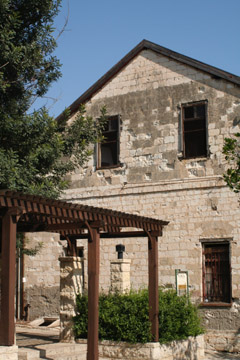 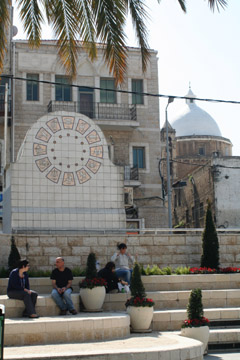
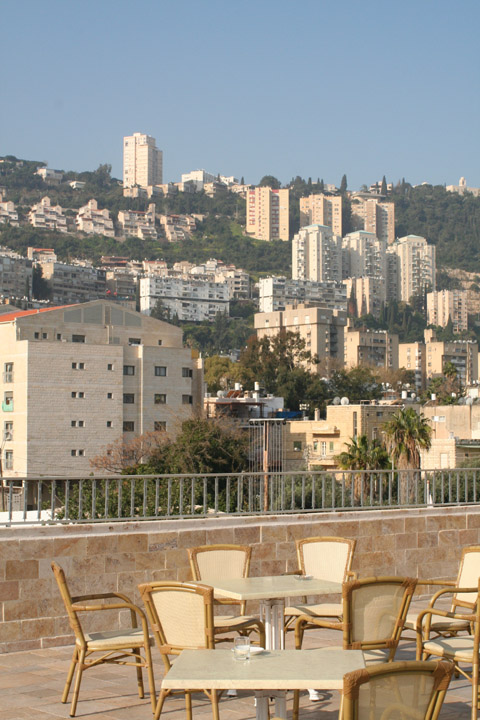
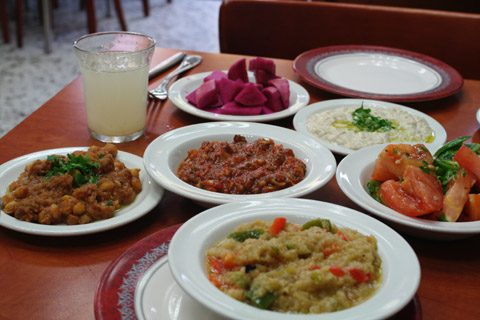
|
 |
Brown smiles broadly when he talks about how everyday life in Haifa defies any preconceptions people may have about Israel in general, and in the most cheerful, life-affirming ways. While there are three distinct quarters for Jews, Christians and Muslims, the borders blur and people mix freely at area markets
Elyse Glickman is US west coast editor of Lucire.
|
